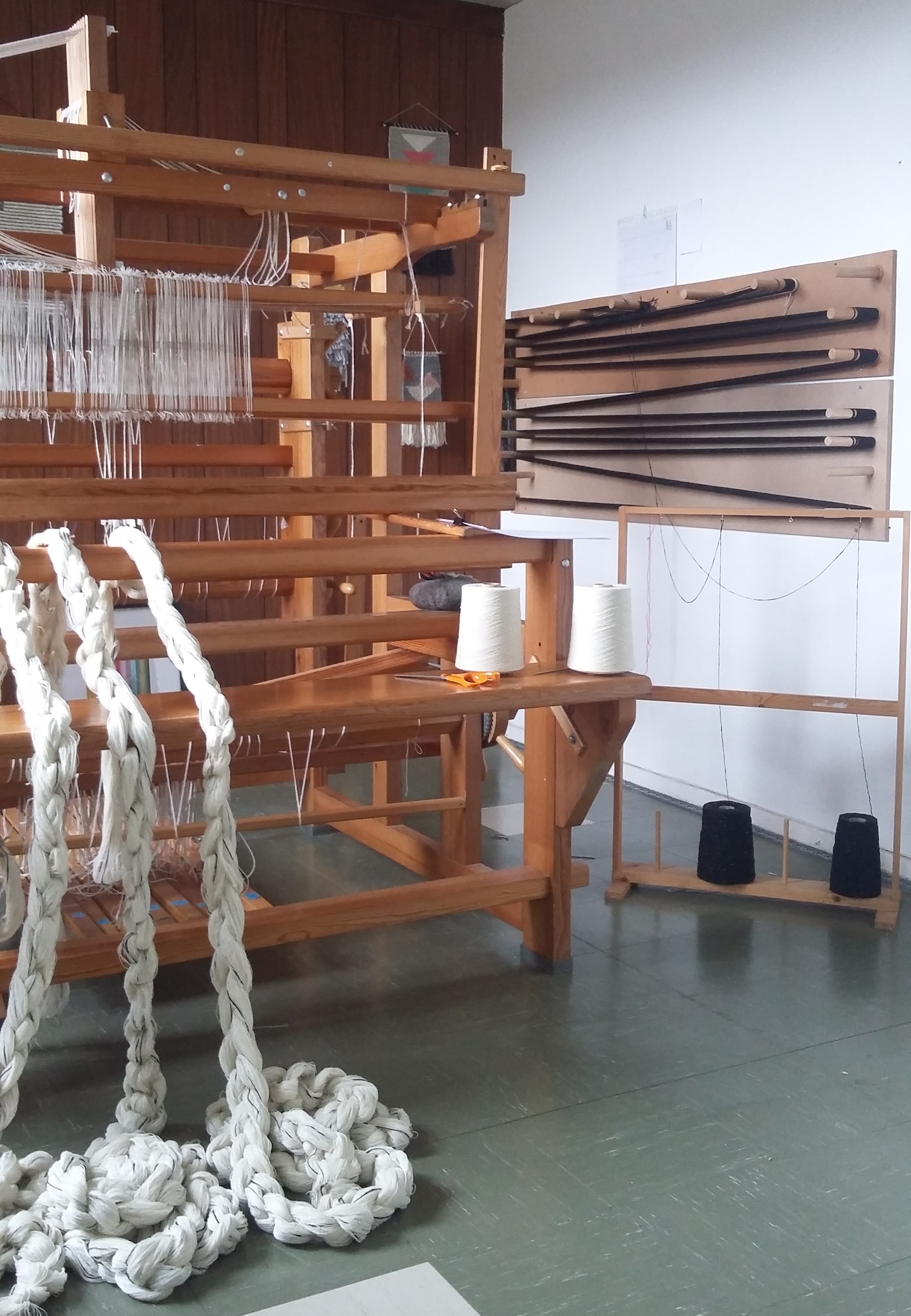Choosing a Loom
Since launching Olla Nua in late 2015 I’ve had the pleasure of teaching tapestry weaving workshops across Northern Ireland. I have happily found that in that short time, the popularity of weaving as a craft has increased, with enthusiastic learners discovering the infinite challenges and rewarding work that it can offer.
I often get asked for advice about choosing a loom to weave on, and it’s no wonder, as there are so many options it can seem overwhelming for new weavers! I’ve put together this post with the intention of highlighting some of the main things to consider and a little insight into my own loom journey.
My loom story – looms for cloth weaving
I currently do most of my weaving on a Swedish Glimakra Standard floor loom, that I was lucky enough to find second-hand from a local weaver at a time when Olla Nua was just an inkling of an idea. We collected it as an unpromising jumble of wood, string and bolts as unfortunately the owner didn’t have the space to show it assembled. It was another couple of years before I had the time and space to get it up and running. A few spare parts and a lot of research, trial and error later, I finally got there!
It’s a large, wide and strong loom, suitable for weaving long lengths of cloth and heavy rugs. The 10 shafts are connected to foot treadles via a series of lamms, pulleys and cords (called a ‘countermarch’ system) that need to be understood and adjusted for each of my different woven designs. It’s a fascinating but somewhat confusing system (except to physics buffs, perhaps), explaining why my loom and I had a bit of a love and hate relationship during our first few years together!
I also have a little vintage Lillstina table loom, purchased cheaply from my art college just before I graduated. They were getting rid of it because it needed a bit of repair and only had 4 shafts, limiting its design capabilities. Like most 'table' looms, the shafts are lifted by hand for each pick of weaving using levers, meaning that it is slower to weave on than floor looms that have foot treadles for this purpose. I usually like to design woven patterns that use at least 8 shafts, but table looms like these are great for sampling more basic weaves on, are simpler to set up and handy to transport. Rigid heddle looms are an even simpler type of table loom that still allow long lengths of cloth to be woven, such as scarves, but are even more portable and usually more affordable.
Tapestry Looms
Tapestry weaving is a great technique for beginner weavers to learn as it requires little equipment and can be used with knotting & wrapping techniques and a huge variety of yarns to experiment with texture, colour and composition. The hands do most of the work, so only simple tools are needed. In tapestry weaving, the warp (vertical yarn held under tension on the frame) is usually entirely covered by the weft (the yarn you weave across the warp), producing a thick, sturdy textile that can be suitable for decorative wall hangings and rugs.
Although you can weave with tapestry techniques using a floor or table (horizontal) loom, it is easier to use a vertical loom so that you can see more of the design as it progresses.
You can start weaving tapestries using just a simple wooden frame and a little knowledge about how to create the warp. I was taught to weave tapestry using this type of simple loom in art college, and I use them in my workshops. An uncovered artist’s stretcher frame (the type that would normally be covered with canvas for painting) is ideal – these can be bought cheaply from art supply shops and marked with measurements for spacing the warp. The warp is wrapped around the frame and then evened out with a taught cord tied across the bottom of the loom to create the weaving base. You can get special frame looms with slots on the front for winding the warp around – these are easier to warp but limit the sett (warp spacing) that you can use.
Smaller frames can be used as you sit in a chair, with the base of the frame resting on your lap and the top of the frame leaning on the edge of a table. Larger frames (your ambition is your limit!)can be used with a stand, clamped to a table or propped against a wall.
The most advanced tapestry looms, often used by professional tapestry artists or those wishing to create large, complex tapestries, have their own stands and may have extra features such as heddle bars (for lifting the warp ends), continuous warping capabilities (allowing a longer warp to be woven than the height of the loom) and warp tensioning.
Weaving on my Ashford tapestry loom - photograph by TACA
In summary – a few tips
* First of all, consider the type of woven textile you want to make (for what purpose), the techniques you would like to use, size of textile you’d like to create and whether speed of weaving is important to you. There are an amazing variety of looms available (or that can be made at home) from the simplest frame or strap to the most complex computerised (and expensive) ones.
* Try out some weaving techniques that need little or no special equipment before committing to a complex or expensive loom. You can weave small tapestries on a simple wooden frame, and long narrow bands using just a door handle or clamp and set of weaving cards.
* Think about second-hand looms – try contacting your local art college as they may be updating their equipment, or check any of the popular buy-and-sell websites for listings. The Loom Exchange is a UK-based website for listing weaving equipment for sale and wanted requests. This is how I found my loom, unusually in Northern Ireland, so you never know what you might find! Be sure to do some research though – see below...
* Before purchasing a complex loom, try to see it set up and in action (and even better, try it out). If you’re thinking of a second-hand loom and this is simply not possible, it can be risky but worthwhile depending on the price and how much time and effort you are prepared to put into figuring out how it works and if there are any missing parts. At the very least, ask the owner to label the components and provide and image of the loom set-up and a manual if possible. Check out the model and manufacturer’s website – they often have downloadable instructions and accessory pricelists. And ask any weavers you know if they have any insights or perhaps own a similar loom, or search and inquire on online forums such as Weavolution.
*If you're thinking about buying a new loom, ask potential suppliers for more information to help you make sure the loom is right for you needs. I haven't yet had the pleasure of buying a brand new loom, but have purchased many tools and parts from George Weil and have always found them very helpful.
Weaving is such a huge subject and there are so many tools and techniques that it can seem difficult to know what to start with. I hope this post has helped a little but just keep in mind that some of the most beautiful and complex woven textiles in the world are created by people with few resources and simple homemade tools. I was lucky enough to witness this first-hand during travels around Peru and Bolivia over a decade ago. I often remind myself of these amazing weavers if I get frustrated about my lack of equipment or struggle with a complex technique.
Best wishes to those of you just beginning your own weaving journey!






